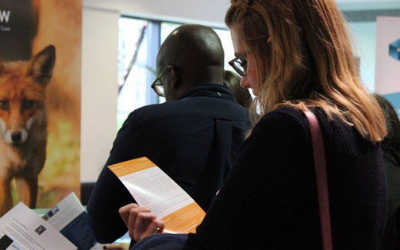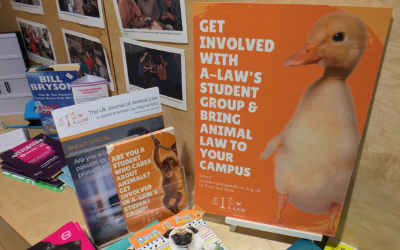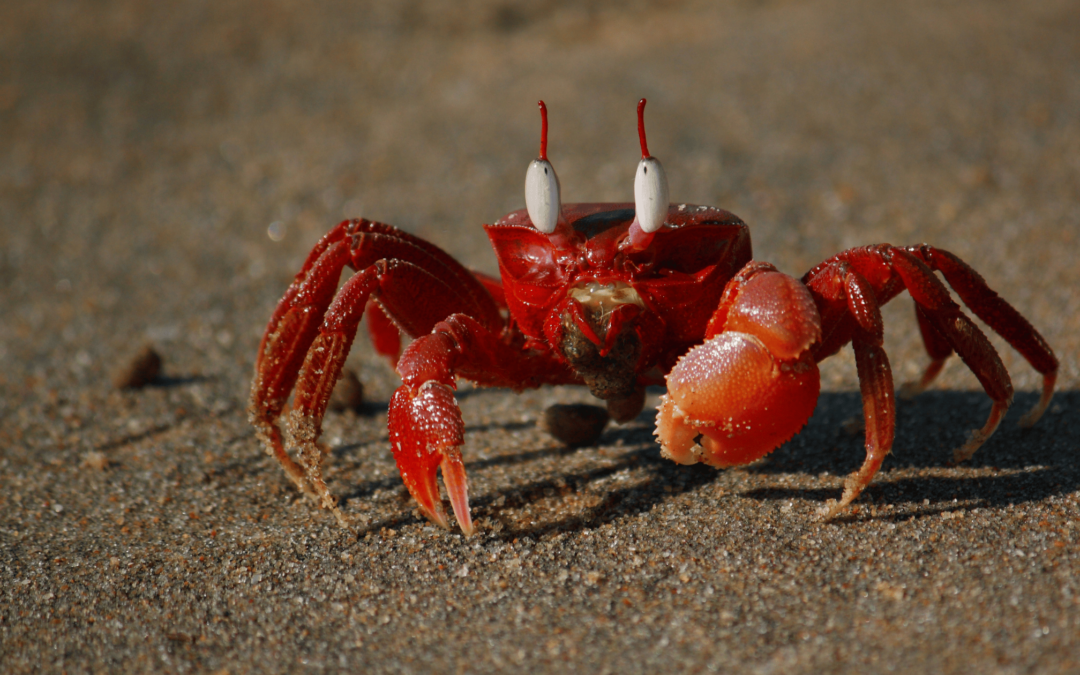by Mary Legge and Nadia Napieraj
On April 13, our Student Chapter held an in-depth consideration of fish & crustacean welfare in the UK, joined online by five speakers and more than 50 attendees. The webinar explored the sentience and intelligence of these aquatic animals, the legal framework affecting them, and relevant campaigns advocating for legislative change. Our speakers Culum Brown, Dr Jonathan Birch, Paula Sparks, Amro Hussain, and Claire Howard presented on these topics. Their insights highlighted the stark contrast between the high level of sentience of fish and crustaceans on the one hand and, on the other hand, the low level of legal protection they are afforded in the UK. Despite this disappointing current legal landscape, the enactment of the Animal Welfare (Sentience) Act 2022 brings hope, as do various campaigns seeking to raise awareness about current legal deficiencies.
Fish Sentience, Cognition and Ethics, Professor Culum Brown (Professor at Macquarie University, Sydney)
Prof Culum Brown presented on fish cognition, which he has studied for 25 years. His research speciality is the application of fish behaviour to fisheries science and conservation. Culum is a well-known champion of fish intelligence, ethics, and welfare.
General facts shared about fish:
- A few years ago, aquaculture overtook commercial fishing from the wild in terms of the source of fishes for human consumption – a major shift in how we use fish.
- Fish are the most popular pet in the world.
- Zebrafish are now overtaking the rat and mouse in terms of use in medical research.
- There are more species of fish than all of the invertebrates combined – 36,000 species.
Fish Intelligence
The results of Pavlov’s famous study of dog behaviour can be replicated with fish, and such studies have shown that fish need only a very short amount of time to learn when to expect food to arrive. Brown’s study with Warburton in 1997 involved rainbow fish and evidenced their ability to retain information over incredibly long periods of time.
Fish also learn socially. A study from Griffiths & Magurran in 1997 showed that fish recognised each other and preferred to be around fish that they were already familiar with. Even after 12 days, this preference persisted. A similar 2006 study by Bhar and Magurran found that this time period could be extended beyond 3 weeks. Fish can also learn unfamiliar behaviour from each other, such as catching live prey, and can even feed off another’s negative fear responses to the live prey (Brown & Laland 2002).
Do Fish Feel Pain?
The simple answer is yes, and this debate has been settled for 20 years. The question that has since been asked is, how do they emotionally engage with this pain?
As we know, jellyfish have stingers. The stickleback has developed spines on its back in response to the pain caused when predators bite down on them, and clownfish who hide amongst the stinging anemone are covered in a thick layer of mucus to protect them.
A study by Sneddon et al while working with Culum at the University of Edinburgh found that the injection of bee venom and acid solution caused fish to stop eating for a period of time. Another study saw fish activity and breathing begin to return to normal levels after receiving pain relief.
Collectively, these facts and findings generate a larger picture of the fish as a sentient, intelligent species. They do not in fact have a 3-second memory!
Positive Fish Welfare?
The scientific reality is this: we’ve known that fish are intelligent animals for a really long time. There is a huge problem with the public perception of fish, which continues to prevent the required change in animal welfare legislation.
The numbers are not absolutely clear, but each year roughly 1 billion fish are used in aquaculture, 1 million tonnes (10 billion individuals) in recreational fishing, and 100 million tonnes (1-3 trillion individuals) in commercial fishing. Although fish are included in animal welfare legislation around the world, enforcement is often especially weak. Fish require better treatment under the law.
Are Crustaceans Sentient? Dr Jonathan Birch (Associate Professor of Philosophy at the LSE and Principal Investigator on the Foundations of Animal Sentience Project)
Our second speaker, Dr Jonathan Birch, presented a concise analysis of the “Review of the Evidence of Sentience in Cephalopod Molluscs and Decapod Crustaceans” LSE Report, which eventually led to cephalopod molluscs and decapod crustaceans being included in the Animal Welfare (Sentience) Act 2022.
Throughout his presentation, he emphasised that the meaning of sentience contemplated in the report is much broader than the ability to feel pain – it also encompasses the feelings of pleasure, hunger, thirst, or excitement. The main guiding principles of the report included the need to integrate evidence from a variety of sources, including behavioural, cognitive, and neural evidence, beyond mere reflexes. Thus, the evidence was based on a range of studies including:
- Robin Crook’s (2021) study revealing that the octopus values anaesthetics when injured. The study constitutes clear behavioural evidence of injured octopus feeling pain, including grooming, skin removal, or concealment. Once an analgesic was applied, the octopus developed a preference for the chamber associated with it.
- Fossat et al (2021) involving an experiment in which crayfish were put in a light maze. The study constitutes behavioural evidence of crayfish exploratory behaviour being significantly suppressed when exposed to electric shocks. Once anti-anxiety medication was given to the crayfish, the exploratory behaviour returned.
- Strausfeld et al (2020) involved the use of antibody staining techniques to identify regions of the brain linked to decapods’ learning and memory, enabling the researchers to arrive at neural evidence considering the expansivity of those regions.
Taking of a global view of the studies, Birch and colleagues concluded that the balance of evidence tilts towards sentience in all the invertebrate groups. The evidence for crustacean sentience is not absolutely conclusive, especially since the studies considered only some key species of cephalopods out of a total 750 species. However, a key guiding principle of the report was the need to communicate uncertainty. Careful generalisation, as happens all the time with vertebrates, is desirable. In the end, it is preferable to assume too much of crustaceans than to risk their welfare.
In addition to recommending the recognition of sentience of cephalopod molluscs and decapod crustaceans in UK legislation, the report also endorses the enactment of enforceable best-practice guidance specific to the need of commercially and scientifically significant species. It also recommends the reinstating of the de-clawing ban, ending online retail of live animals to untrained handlers, and prohibiting the live boiling without prior stunning of crayfish and lobsters.
How does the legal landscape compare? Paula Sparks (Chair at UK Centre for Animal Law and Visiting Lecturer at University of Winchester)
Paula Sparks explored the protections afforded by UK law to farmed fish, cephalopods, and crustaceans. She started by highlighting the very limited protection for these species at the time of slaughter.
EU Council Regulation 1009/2009 requires that animals should be spared any avoidable pain, distress, or suffering during their killing (Article 3(1)); however, this provision only extends to vertebrates (which therefore incudes fish) with the exception of reptiles and amphibians (Article 2(c)). Invertebrates, such as crustaceans and cephalopods, are outside its scope. While Article 3(1) does include fish, the detailed provisions in Regulation 1009/2009 about slaughter methods for different species do not apply to fish. While it was envisaged in 2009 that separate standards would be developed for fish, this has not happened.
The UK has retained EU law. Domestic law in England and Wales purportedly goes further than the EC regulations, as the Welfare of Animals at the Time of Killing (England) Regulations 2015 (‘WATOK’) and equivalent in the devolved regions extend the scope of general protection to reptiles and invertebrates. However, there is little or no evidence of enforcement.
In relation to farming standards of care for fish and crustaceans at UK level: Although the Council Directive 98/58/EC seeks to protect farmed animals by requiring Member States to enact legislation requiring farmers to take reasonable steps to ensure their welfare (Article 3), it specifically excludes invertebrates (Article 1(2)). There are no legal standards for fish in the UK, as the Welfare of Farmed Animals Regulations[1], implementing the Directive, specifically exclude fish.
Although there is some protection of fish and crustaceans in commercial transport, the practical impact of these provisions is limited due to their geographical extent. Article 3 of the Council Regulation No 1/2005 makes it an offence to transport vertebrates, including fish, in connection with an economic activity, in a way that is likely to cause injury or undue suffering to them. The UK extends this duty to cold-blooded invertebrates,[2] including crustaceans. However, this does not apply in Scotland, where a large part of UK aquaculture is located, which means that there is a danger that a significant number of fish and crustaceans used commercially in the UK are suffering during transport.
The overall landscape for the legal protection of fish and invertebrate species is poor and there is an imperative to advocate for stronger laws and better enforcement of existing laws.
The Forgotten Fish Campaign, Amro Hussain (Senior Public Affairs Lead for The Humane League (THL))
Amro Hussain provided us with an overview of The Humane League’s Forgotten Fish Campaign. The campaign focuses on fish welfare in slaughter, in particular advocating for enforceable stunning requirements. The WATOK Regulations provide detailed guidance on how to handle, transport, stun, and slaughter terrestrial farm animals, but give no specific equivalent for fish. This leaves fish at significant risk of suffering. Another welfare issue THL have identified is the confinement and high stocking density in fish farming, which not only leads to stress (which is detrimental to health and lifespan) but also the spread of sea lice, which feed on their blood and skin, causing chronic stress and even mass mortality.
Norway currently has an existing legislative requirement to stun fish before slaughter. These changes are not likely to have a significant impact on trade given the likelihood that stunning methods are already used to an extent. Enshrining welfare standards in law will ensure that higher welfare producers cannot be undercut by their lower welfare counterparts. THL therefore hope that, in focusing on this area, they have an increased chance of seeing a first positive step taken towards fish welfare.
In their research, THL found that there is public support for improved fish welfare. Only 8% of UK adults think that fish do not feel pain, and 71% agree that farmed fish should have the same legal protections as other farmed animals. However, the problem is that many people do not even know that fish farming exists, and so neither do they know the welfare issues presented by it.
What has the Forgotten Fish campaign achieved so far? THL has explored a number of avenues to push for change, including the use of social media to expose truths about the industry and attempt to change public perception through storytelling. In the political realm, they have engaged extensively with parliamentarians, and Hussain delivered a presentation on the campaign to the Scottish Cross Party Group on Animal Welfare.
THL supporters have drawn and sent postcards with images of fish to the government. The Animal Welfare Committee (AWC) is currently updating its opinion on the welfare of farmed fish at the time of killing, and THL submitted evidence for this. There is also hope to coordinate efforts with other animal organisations to avoid duplication and amplify the message to the government.
The campaign’s next steps include the AWC’s updated opinion arriving this summer, and THL are hopeful that this will be the third time that the government are told that fish need equivalent protection.
Claire Howard (Executive Director, Crustacean Compassion)
Claire Howard has been campaigning for the legal protection and humane treatment of decapod crustaceans since Crustacean Compassion (CC) was founded in 2016. Claire informed us that approximately 420 million decapod crustaceans are landed by UK vessels into UK ports annually, and that this number is likely to be an underrepresentation. There are a wide range of welfare issues that face these creatures, causing them extreme stress and contributing to mortality.
Capture methods vary depending on geographic location but may include trawling, a hugely aggressive and traumatic experience for the animals. Transport presents issues, such as being stored in unsuitable environments for long periods of time, and overcrowding. Crustaceans have even been sold and delivered to homes through Amazon. Shrink-wrap, tanks, being placed on ice, poor water quality, and extreme temperatures are all things experienced whilst in storage, the impacts of which can be severe.
Crustaceans are mutilated in many abhorrent ways, from the eyestalk ablations of shrimp and prawns to declawing of crabs. The horrors they face in slaughter are also widely appreciated; many are familiar with the idea of the animals being boiled alive. Misconceptions can lead to more suffering: some people will place them in freezers to lose consciousness beforehand, which in effect only means that it takes longer for their core temperature to increase. Freshwater drowning and live carving are other methods of slaughter. Handling practices and laboratory experiments are also of huge concern to crustacean welfare.
Since their creation, Crustacean Compassion have worked tirelessly to create a case for change. Beginning with a petition which received huge support, they have also written an open letter that has been subsequently signed by many experts, and have regularly engaged with other animal welfare organisations.
What is next? Crustacean Compassion believe enforceable codes of practice must be generated, along with requirements in practice such as monitoring the numbers of animals and who uses them. CC also recognise that sharing expertise and knowledge and working together with the industry will be key to achieving change.
What can we do?
More needs to be done to help close the gaps between the treatment of fish and other non-human animals. This can and must begin with the public, to show that there is support for change. Engage with the online content of animal welfare organisations, share and sign petitions, and as Hussain advocates, write to your MP/MSP. These small actions have a bigger impact than we may think. And if you can, donate to organisations doing the work.
We’ve included some helpful links below:
You can sign up to the THL newsletter here, which will provide you with much more information on how you can support the campaign







